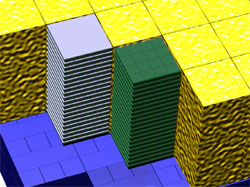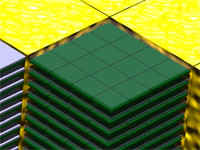|


LAT baseline design for the GLAST tracker consists of a four-by-four array of tower
modules. Each tower module consists of interleaved planes of silicon-strip detectors and tungsten converter
sheets. Silicon-strip detectors are able to more precisely track the electron or positron
produced from the initial gamma-ray than previous types of detectors. SSDs will have the
ability to determine the location of an object in the sky to within 0.5 to 5 arc minutes.
The pair conversion signature is also used to help reject the much larger background of
charged cosmic rays. The high intrinsic efficiency and reliability of this technology
enables straight forward event reconstruction and excellent resolution with small tails. These
ease-of-use properties will maximize the mission science return for guest observers. tungsten converter
sheets. Silicon-strip detectors are able to more precisely track the electron or positron
produced from the initial gamma-ray than previous types of detectors. SSDs will have the
ability to determine the location of an object in the sky to within 0.5 to 5 arc minutes.
The pair conversion signature is also used to help reject the much larger background of
charged cosmic rays. The high intrinsic efficiency and reliability of this technology
enables straight forward event reconstruction and excellent resolution with small tails. These
ease-of-use properties will maximize the mission science return for guest observers.
In each module, there are 19 pairs  of planes of silicon - in each pair, one
plane has the strips oriented in the "x-direction", while the other has the
strips oriented in the perpendicular "y-direction". When a particle interacts in
the silicon, its position on the plane can therefore be determined in two dimensions. The
third dimension of the track is determined by analyzing signals from adjacent planes, as
the particle travels down through the telescope towards the calorimeter. of planes of silicon - in each pair, one
plane has the strips oriented in the "x-direction", while the other has the
strips oriented in the perpendicular "y-direction". When a particle interacts in
the silicon, its position on the plane can therefore be determined in two dimensions. The
third dimension of the track is determined by analyzing signals from adjacent planes, as
the particle travels down through the telescope towards the calorimeter.

|